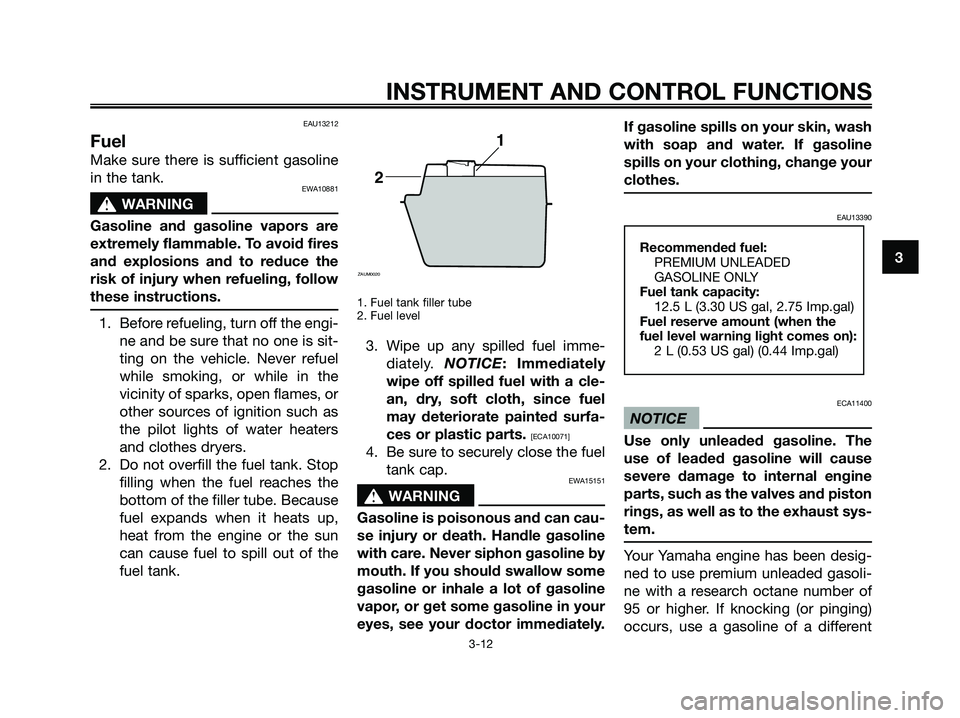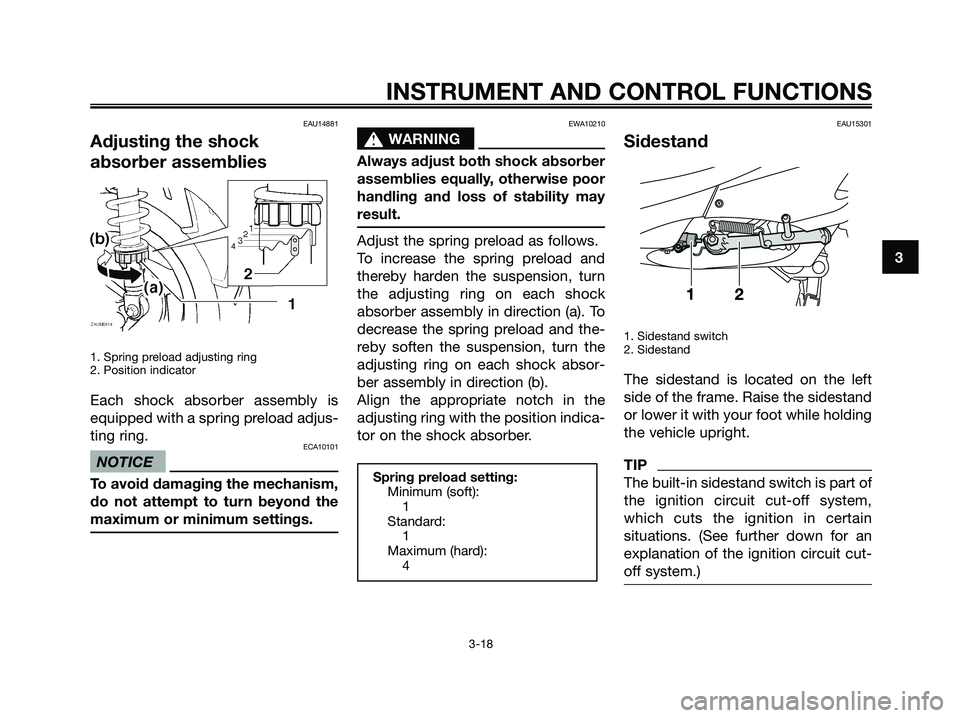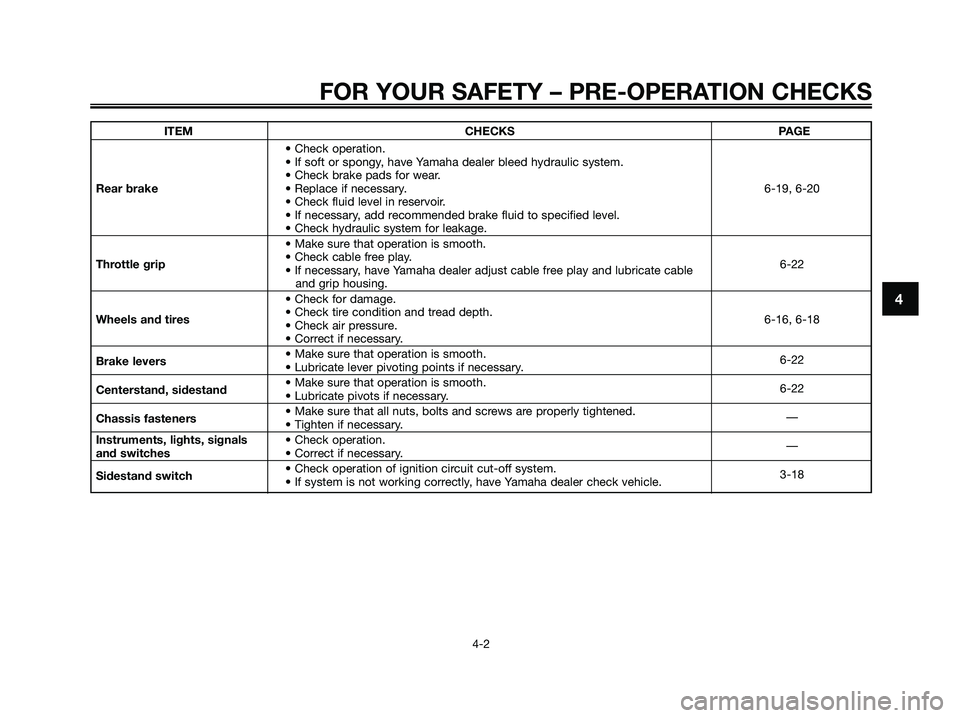2009 YAMAHA XMAX 125 ignition
[x] Cancel search: ignitionPage 6 of 92

SAFETY INFORMATION .....................1-1
Further safe-riding points .................1-5
DESCRIPTION.....................................2-1
Left view ...........................................2-1
Right view .........................................2-2
Controls and instruments .................2-3
INSTRUMENT AND CONTROL
FUNCTIONS ........................................3-1
Immobilizer system ...........................3-1
Main switch/steering lock .................3-2
Indicator and warning lights .............3-3
Turn signal indicator lights ...............3-3
High beam indicator light ................3-3
Fuel level warning light ....................3-4
Engine trouble warning light ............3-4
Immobilizer system indicator light ...3-4
Speedometer ....................................3-5
Fuel gauge ........................................3-5
Coolant temperature gauge..............3-5
Multi-function display .......................3-6
Anti-theft alarm (optional) .................3-9
Handlebar switches ..........................3-9
Dimmer switch .................................3-9
Turn signal switch ............................3-9
Horn switch .....................................3-9
Start switch ......................................3-9
Hazard switch ................................3-10
Front brake lever.............................3-10
Rear brake lever..............................3-10Fuel tank cap ..................................3-11
Fuel .................................................3-12
Catalytic converters ........................3-13
Securing bracket ............................3-14
Seat.................................................3-14
Storage compartments ...................3-15
Front storage compartment............3-16
Rear storage compartment.............3-17
Adjusting the shock absorber
assemblies...................................3-18
Sidestand ........................................3-18
Ignition circuit cut-off system .........3-19
FOR YOUR SAFETY – PRE-
OPERATION CHECKS ........................4-1
OPERATION AND IMPORTANT
RIDING POINTS ..................................5-1
Starting the engine ...........................5-1
Starting off ........................................5-2
Acceleration and deceleration ..........5-3
Braking..............................................5-3
Tips for reducing fuel consumption..5-4
Engine break-in.................................5-4
Parking ..............................................5-5
PERIODIC MAINTENANCE AND
ADJUSTMENT ....................................6-1
Owner’s tool kit .................................6-1
Periodic maintenance and
lubrication chart ............................6-2Periodic maintenance chart for the
emission control system ...............6-2
General maintenance and
lubrication chart ............................6-3
Removing and installing the
cowlings and panel .......................6-6
Checking the spark plug ..................6-8
Engine oil ..........................................6-9
Final transmission oil ......................6-12
Coolant ...........................................6-13
Air filter and V-belt case air filter
elements ......................................6-14
Adjusting the throttle cable free
play ..............................................6-15
Valve clearance ...............................6-16
Tires ................................................6-16
Cast wheels ....................................6-18
Front and rear brake lever free
play ..............................................6-19
Checking the front and rear brake
pads.............................................6-19
Checking the brake fluid level ........6-20
Changing the brake fluid ................6-21
Checking and lubricating the
cables ..........................................6-21
Checking and lubricating the throttle
grip and cable .............................6-22
Lubricating the front and rear
brake levers .................................6-22
Checking and lubricating the
centerstand and sidestand .........6-22
TABLE OF CONTENTS
1B9-F8199-E3.QXD 21/10/08 13:42 Página 6
Page 17 of 92

●Keep other immobilizer system
keys away from the main
switch as they may cause sig-
nal interference.EAU10471
Main switch/steering lock
The main switch/steering lock con-
trols the ignition and lighting systems,
and is used to lock the steering.
TIP
Be sure to use the standard key
(black bow) for regular use of the
vehicle. To minimize the risk of losing
the code re-registering key (red bow),
keep it in a safe place and only use it
for code re-registering.
EAU34121
ON
All electrical circuits are supplied with
power; the meter lighting, taillight,
license plate light and auxiliary lights
come on, and the engine can be star-
ted. The key cannot be removed.
TIP
The headlights come on automatically
when the engine is started and stay
on until the key is turned to “OFF” or
the sidestand is moved down.
EAU10661
OFF
All electrical systems are off. The key
can be removed.
EWA10061
s s
WARNING
Never turn the key to “OFF” or
“LOCK” while the vehicle is
moving. Otherwise the electrical
systems will be switched off, which
may result in loss of control or an
accident.
INSTRUMENT AND CONTROL FUNCTIONS
3-2
3
1B9-F8199-E3.QXD 21/10/08 13:42 Página 17
Page 27 of 92

EAU13212
Fuel
Make sure there is sufficient gasoline
in the tank.
EWA10881
s s
WARNING
Gasoline and gasoline vapors are
extremely flammable. To avoid fires
and explosions and to reduce the
risk of injury when refueling, follow
these instructions.
1. Before refueling, turn off the engi-
ne and be sure that no one is sit-
ting on the vehicle. Never refuel
while smoking, or while in the
vicinity of sparks, open flames, or
other sources of ignition such as
the pilot lights of water heaters
and clothes dryers.
2. Do not overfill the fuel tank. Stop
filling when the fuel reaches the
bottom of the filler tube. Because
fuel expands when it heats up,
heat from the engine or the sun
can cause fuel to spill out of the
fuel tank.
1. Fuel tank filler tube
2. Fuel level
3. Wipe up any spilled fuel imme-
diately. NOTICE: Immediately
wipe off spilled fuel with a cle-
an, dry, soft cloth, since fuel
may deteriorate painted surfa-
ces or plastic parts.
[ECA10071]
4. Be sure to securely close the fuel
tank cap.
EWA15151
s s
WARNING
Gasoline is poisonous and can cau-
se injury or death. Handle gasoline
with care. Never siphon gasoline by
mouth. If you should swallow some
gasoline or inhale a lot of gasoline
vapor, or get some gasoline in your
eyes, see your doctor immediately.If gasoline spills on your skin, wash
with soap and water. If gasoline
spills on your clothing, change your
clothes.
EAU13390
ECA11400
NOTICE
Use only unleaded gasoline. The
use of leaded gasoline will cause
severe damage to internal engine
parts, such as the valves and piston
rings, as well as to the exhaust sys-
tem.
Your Yamaha engine has been desig-
ned to use premium unleaded gasoli-
ne with a research octane number of
95 or higher. If knocking (or pinging)
occurs, use a gasoline of a different
Recommended fuel:
PREMIUM UNLEADED
GASOLINE ONLY
Fuel tank capacity:
12.5 L (3.30 US gal, 2.75 Imp.gal)
Fuel reserve amount (when the
fuel level warning light comes on):
2 L (0.53 US gal) (0.44 Imp.gal)
1
2
ZAUM0020
INSTRUMENT AND CONTROL FUNCTIONS
3-12
3
1B9-F8199-E3.QXD 21/10/08 13:42 Página 27
Page 33 of 92

EAU14881
Adjusting the shock
absorber assemblies
1. Spring preload adjusting ring
2. Position indicator
Each shock absorber assembly is
equipped with a spring preload adjus-
ting ring.
ECA10101
NOTICE
To avoid damaging the mechanism,
do not attempt to turn beyond the
maximum or minimum settings.
EWA10210
s s
WARNING
Always adjust both shock absorber
assemblies equally, otherwise poor
handling and loss of stability may
result.
Adjust the spring preload as follows.
To increase the spring preload and
thereby harden the suspension, turn
the adjusting ring on each shock
absorber assembly in direction (a). To
decrease the spring preload and the-
reby soften the suspension, turn the
adjusting ring on each shock absor-
ber assembly in direction (b).
Align the appropriate notch in the
adjusting ring with the position indica-
tor on the shock absorber.
EAU15301
Sidestand
1. Sidestand switch
2. Sidestand
The sidestand is located on the left
side of the frame. Raise the sidestand
or lower it with your foot while holding
the vehicle upright.
TIP
The built-in sidestand switch is part of
the ignition circuit cut-off system,
which cuts the ignition in certain
situations. (See further down for an
explanation of the ignition circuit cut-
off system.)Spring preload setting:
Minimum (soft):
1
Standard:
1
Maximum (hard):
4
INSTRUMENT AND CONTROL FUNCTIONS
3-18
3
1B9-F8199-E3.QXD 21/10/08 13:42 Página 33
Page 34 of 92

EWA10240
s s
WARNING
The vehicle must not be ridden with
the sidestand down, or if the sides-
tand cannot be properly moved up
(or does not stay up), otherwise the
sidestand could contact the ground
and distract the operator, resulting
in a possible loss of control. Yama-
ha’s ignition circuit cut-off system
has been designed to assist the
operator in fulfilling the responsibi-
lity of raising the sidestand before
starting off. Therefore, check this
system regularly as described
below and have a Yamaha dealer
repair it if it does not function pro-
perly.
EAU45051
Ignition circuit cut-off
system
The ignition circuit cut-off system
(comprising the sidestand switch and
brake light switches) has the following
functions.
●It prevents starting when the
sidestand is up, but neither brake
is applied.
●It prevents starting when either
brake is applied, but the sides-
tand is still down.
●It cuts the running engine when
the sidestand is moved down.
Periodically check the operation of
the ignition circuit cut-off system
according to the following procedure.
INSTRUMENT AND CONTROL FUNCTIONS
3-19
3
1B9-F8199-E3.QXD 21/10/08 13:42 Página 34
Page 37 of 92

FOR YOUR SAFETY – PRE-OPERATION CHECKS
4-2
4
ITEM CHECKS PAGE
• Check operation.
• If soft or spongy, have Yamaha dealer bleed hydraulic system.
• Check brake pads for wear.
Rear brake• Replace if necessary. 6-19, 6-20
• Check fluid level in reservoir.
• If necessary, add recommended brake fluid to specified level.
• Check hydraulic system for leakage.
• Make sure that operation is smooth.
Throttle grip• Check cable free play.
6-22
• If necessary, have Yamaha dealer adjust cable free play and lubricate cable
and grip housing.
• Check for damage.
Wheels and tires• Check tire condition and tread depth.
6-16, 6-18
• Check air pressure.
• Correct if necessary.
Brake levers• Make sure that operation is smooth.
• Lubricate lever pivoting points if necessary.6-22
Centerstand, sidestand• Make sure that operation is smooth.
• Lubricate pivots if necessary.6-22
Chassis fasteners• Make sure that all nuts, bolts and screws are properly tightened.
• Tighten if necessary.—
Instruments, lights, signals • Check operation.
and switches• Correct if necessary.—
Sidestand switch • Check operation of ignition circuit cut-off system.
• If system is not working correctly, have Yamaha dealer check vehicle.3-18
1B9-F8199-E3.QXD 21/10/08 13:42 Página 37
Page 38 of 92

EAU15951
Read the Owner’s Manual carefully to
become familiar with all controls. If
there is a control or function you do
not understand, ask your Yamaha
dealer.
EWA10271
s s
WARNING
Failure to familiarize yourself with
the controls can lead to loss of
control, which could cause an acci-
dent or injury.
EAU45310
TIP
This model is equipped with a lean
angle sensor to stop the engine in
case of a turnover. To start the engine
after a turnover, be sure to turn the
main switch to “OFF” and then to
“ON”. Failing to do so will prevent the
engine from starting even though the
engine will crank when pushing the
start switch.
EAUM2231
Starting the engineECA10250
NOTICE
See page 5-4 for engine break-in
instructions prior to operating the
vehicle for the first time.
In order for the ignition circuit cut-off
system to enable starting, the sides-
tand must be up.
See page 3-19 for more information.
1. Turn the key to “ON”.
The following warning lights and
indicator light should come on for
a few seconds, then go off.
●Fuel level warning light
●Engine trouble warning light
●Immobilizer system indicator
light
ECA11831
NOTICE
If a warning or indicator light does
not go off, see page 3-3 for the
corresponding warning and indica-
tor light circuit check.
2. Close the throttle completely.
OPERATION AND IMPORTANT RIDING POINTS
5-1
5
1B9-F8199-E3.QXD 21/10/08 13:42 Página 38
Page 69 of 92
![YAMAHA XMAX 125 2009 Owners Manual to avoid causing extensive
damage to the electrical sys-
tem and possibly a fire.
[EWA15131]
1. Signaling system fuse
2. Hazard fuse
3. Radiator fan fuse
4. ECU (Electronic Control Unit) fuse
5. Igni YAMAHA XMAX 125 2009 Owners Manual to avoid causing extensive
damage to the electrical sys-
tem and possibly a fire.
[EWA15131]
1. Signaling system fuse
2. Hazard fuse
3. Radiator fan fuse
4. ECU (Electronic Control Unit) fuse
5. Igni](/manual-img/51/52864/w960_52864-68.png)
to avoid causing extensive
damage to the electrical sys-
tem and possibly a fire.
[EWA15131]
1. Signaling system fuse
2. Hazard fuse
3. Radiator fan fuse
4. ECU (Electronic Control Unit) fuse
5. Ignition fuse
6. Backup fuse
7. Spare fuse
8. Spare fuse
9. Spare fuse
3. Turn the key to “ON” and turn on
the electrical circuit in question to
check if the device operates.
4. If the fuse immediately blows
again, have a Yamaha dealer
check the electrical system.
Specified fuses:
Main fuse:
30.0 A
ECU (Electronic Control Unit)
fuse:
5.0 A
Signaling system fuse:
15.0 A
Ignition fuse:
5.0 A
Headlight fuse:
15.0 A
Backup fuse:
5.0 A
Radiator fan fuse:
10.0 A
PERIODIC MAINTENANCE AND ADJUSTMENT
6-27
6
1B9-F8199-E3.QXD 21/10/08 13:43 Página 69